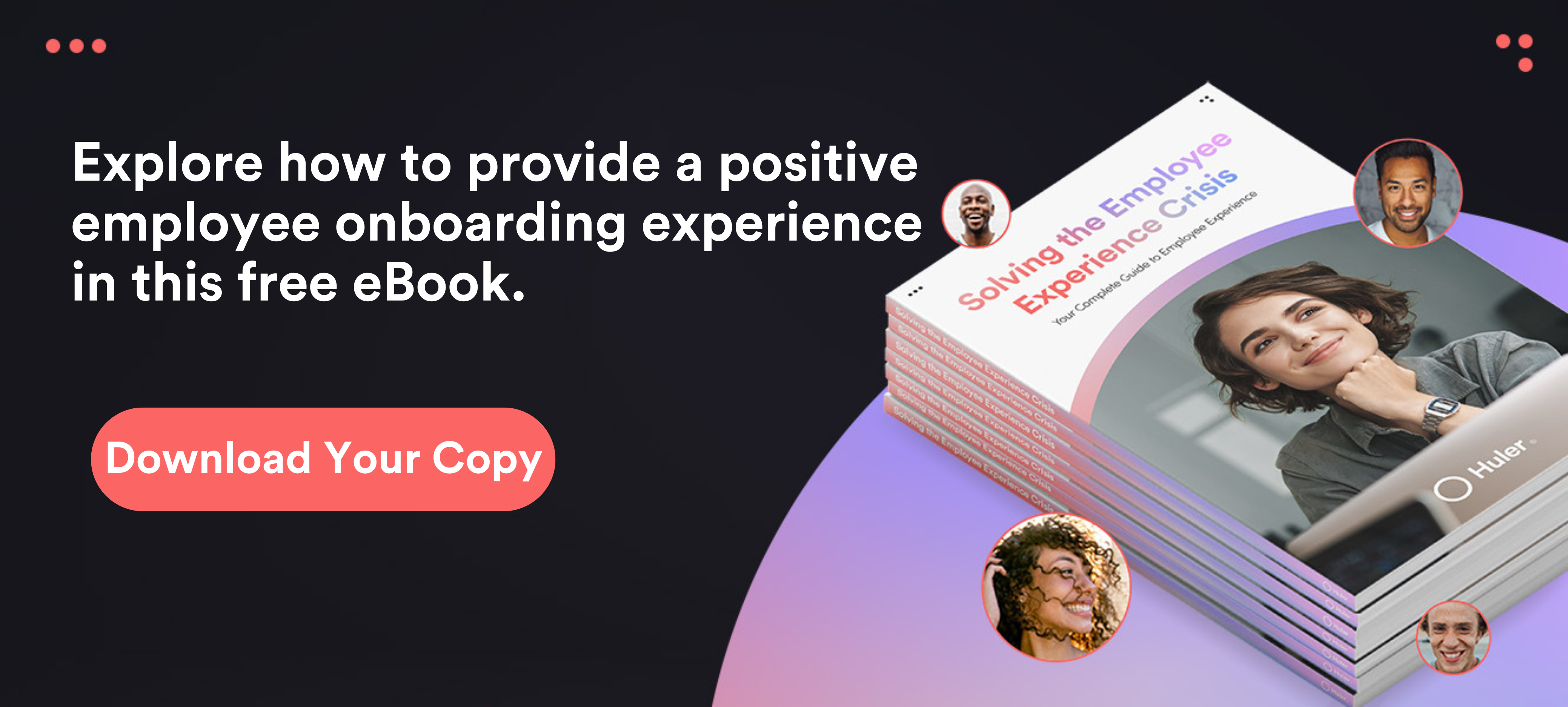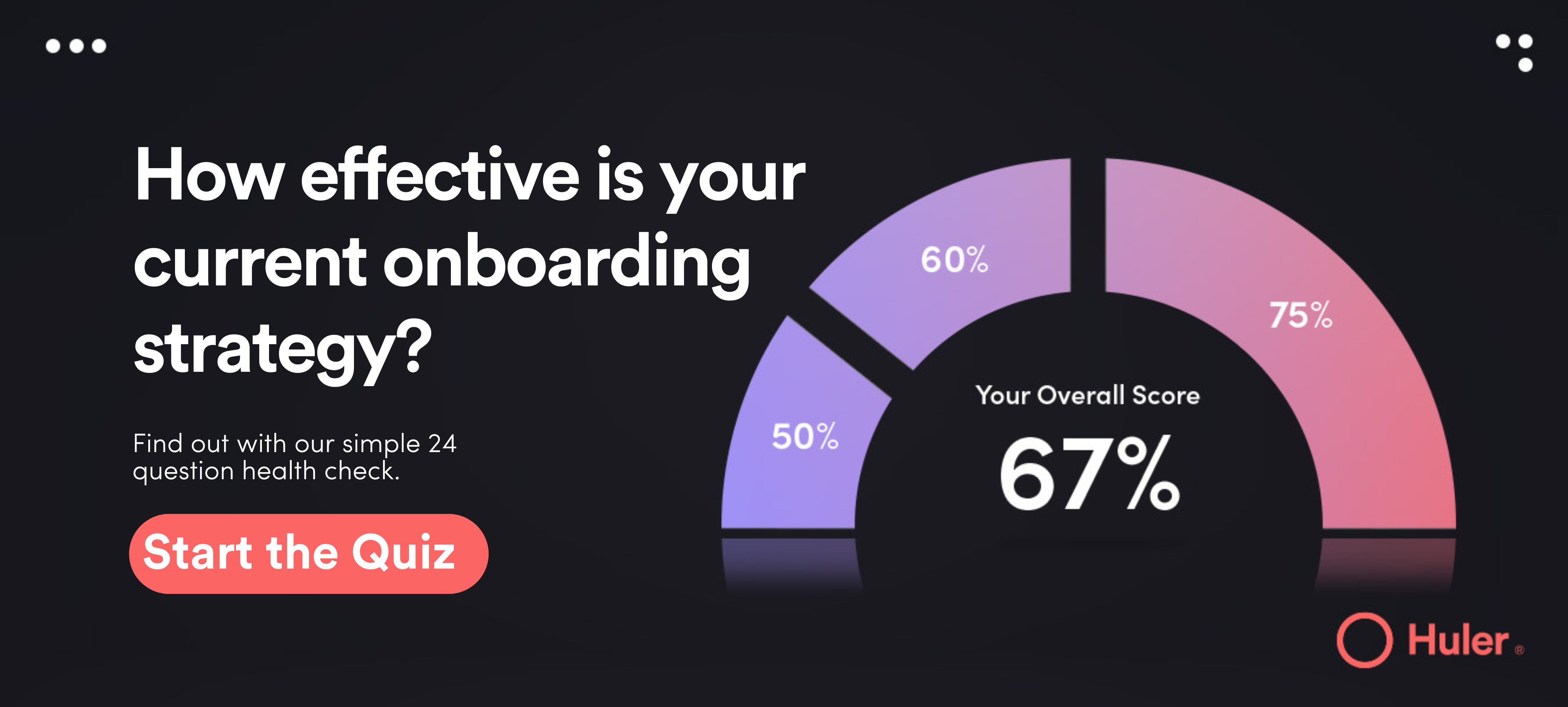Recruitment and onboarding is a consistent sticking point for HR Managers. Why? Well, get it wrong and you could lose out on talent quicker than you can say “You’re hired!” in your best Alan Sugar voice. And then there’s all the paperwork that comes with it. Oh, the never-ending paperwork. What should be a human-focused experience can quickly devolve into a compliance exercise where new hires spend the bulk of their first day filling out forms and looking around frantically for the toilets and coffee machine.
This isn’t just us being overdramatic, either. According to recent studies, 58% of organisations say that their onboarding program is focused on processes and paperwork. What’s more, according to statistics from Enboarder, 25% of companies lose up to 60% of their entire workforce within a year. Something clearly isn’t working with onboarding processes across the board, and it’s going to get much worse given the rise of remote working kickstarted by the pandemic, which is no doubt set to continue.
Isn’t it time we did something about it?
It’s clear from the stats noted above that onboarding processes that focus on paperwork and processes aren’t effective enough. Instead your organisation needs to focus on creating a people-first employee onboarding process in 2022. That is, an onboarding process that is built with the goal of high employee engagement and retention in contrast to the compliance exercises our onboarding processes have begun.
Let’s explore how it can be done.
What Is An Employee Onboarding Process?
An onboarding process is a plan purposefully devised by HR or People Managers to introduce a newly hired employee to their new role and duties, the organisation, their colleagues, the culture and workplace processes.
The core aims of an onboarding process is to:
- Make a positive first impression
- Introduce the new employee to the organisation (e.g. core values, structure, colleagues, workplace culture etc)
- Help them to understand where they fit in the business and how they (and their team) contribute to the overarching company goals
- Develop their knowledge of internal processes and functions as well as provide core training related to the role
- Empower them with the knowledge and confidence to thrive in their role
Note how the list above doesn’t mention filling out paperwork as one of the core goals of the onboarding process? While there’s no denying that compliance is important when bringing on a new employee, it shouldn’t be what stands out to new employees or leaves a lasting impression on them. Instead, HR and People Managers should set out to create employee onboarding processes that signals to employees what they can expect from your organisation.

Steps To A People-First Employee Onboarding Process
Effective employee onboarding should consist of a carefully planned step by step process or journey. How long, you ask? Well, the jury might be out on that one with various sources suggesting anywhere between 3 months and 9 months. Safe to say, however, it’s recommended that your employee onboarding process should run for more than a month for maximum effect!
The different steps in the employee onboarding process can vary depending on the type of onboarding. For example, a remote onboarding process might not include a tour of the office, as this might not be relevant or interesting to an employee who lives at the other end of the country and is unlikely to visit. Therefore, when you’re planning out your own onboarding process, it’s wise to take some time to think about what an employee might expect from their onboarding experience and the context in which it will happen.
Before we look at that, though, let’s explore a few possible steps in the employee onboarding process and what they might look like…
Step 1: Recruitment
Onboarding doesn’t start on an employee’s first day. It starts with their first few interactions with your business. This could be a job advert hosted on a third-party website, your organization’s presence on networking platforms like LinkedIn, your company’s website, the job specification or the interview process.
How to make it people-first:
Every touchpoint in the employee onboarding process gives employees a sense of what life will be like as part of your organisation, so it’s absolutely crucial to ensure you are making a consistent positive first impression.
Take great care to ensure all of your content and comms are communicating the same message, from your company mission and core values to what makes your workplace culture great. Use feedback from exit interviews or past recruiting experiences to anticipate what is most important to prospective employees and ensure what is important to them accurately communicated as early on in the process as possible.
Step 2: Between Offer & Start Date (AKA No Man’s Land)
This part of the onboarding process is famously difficult to handle, particularly with candidates serving a lengthy notice period. It’s all too easy for your future new starters to go off the boil at this time, or worse still…accept a counter offer from their current employer!
In our opinion, this is one part of the employee onboarding process that is severely neglected. However, spending some time understanding how you can keep your future new employees ‘warm’ during this stage can pay dividends when it comes to retention and setting yourself up for future high engagement and success.
How to make it people first:
This no man’s land in the employee onboarding process is sometimes referred to as pre-boarding – and it’s also a big milestone in the employee experience. But what exactly can you do at this point of the journey to make a good impression?
Here are a few ideas to personalise the pre-boarding experience:
- Ask the new employee to create a short bio along with a picture which can be circulated around the team
- Share with the new employee a ‘Who’s Who’ document that will help them put faces to names ahead of the big day
- Encourage current employees to reach out via LinkedIn or email. Or better still, arrange an informal group video call for introductions
- Send a congratulations card and/or gift ahead of their first day
- Set up your new employee’s company email and calendar ahead of the big day and share important information with them so they know what to expect.
- Share key documents ahead of time such as your employee handbook
It’s important to strike a good balance between sharing the right amount of information and not overwhelming your new employee. Your goal is to make them feel included and to minimise any ‘first day’ nerves they might have, not have them starting work before they have officially started work. So tread carefully and above all, make your pre-boarding journey personal!
Step 3: First Day
Whether a candidate is remote or on-site, the first day is hands down one of the most nerve wracking and crucial parts of the employee onboarding process. How this day pans out will depend on a lot of factors. For example, if a new employee is on-site, there should be a tour along with housekeeping such as fire safety, where the toilets are, how to use the coffee machine and getting settled at their new desk.
How to make it people first:
By and large, though, what new employees need from their first day is the same:
- Clear communication
- An organised (but not too stringent) itinerary
- To feel part of the team
- Make it people first:
When you plan a new hire’s first day as part of the employee onboarding process, be sure to personalise it for different roles, circumstances and contexts.
For example, remote employees won’t have the chance to bump into colleagues at the coffee machine or sit next to someone on their team they can chat with. So, you should aim to recreate these interactions as far as possible. One way of doing this might be to assign new starters a ‘buddy’ they can talk to at the start of the day and the end of it to help them feel more connected and give them a port of call for questions.
It goes without saying that your new employee’s workspace should be fully kitted out and ready for them on the first day. Whether remote or in-person, make sure they are armed and ready with logins and other pertinent information that will make getting set up as swift and painless as possible. A few welcome gifts wouldn’t go amiss either!
Finally, have a clear plan of action for your new employees. Let them know in advance how the day will be structured and stick to the script as far as possible. While you don’t want to run them ragged and overload them with information, neither do you want them sitting on their lonesome twiddling their thumbs waiting to be told what to do next. Be clear with them what you want them to achieve from their first day and then give them the tools and information to do so.
Step 4: The First Month
Time flies when you’re having fun! And before you know it your new employee is getting their first payslip and getting stuck into their work. Job done, right? Well, not quite.
During this time a lot of HR Managers and People teams lose control of the onboarding process. This is especially true in big companies, or those going through a big recruitment drive where newbies don’t stay new for long. It’s easy to lose sight of the not-so-new starters and just let them get on with it.
However, there is a huge opportunity to be seized in these first few weeks related to cementing a new employee’s place in the company.
Make it people first:
Visibility of and access to leaders in the workplace can be transformative for workplace culture. New employees in particular need to see and feel this in action to truly feel the full benefit of it, so make sure you’re scheduling in some time for them to meet all (or part of) the leadership team.
On top of this, during their first month employees should have a one to one with their manager where they set goals and key performance indicators alongside a personal development plan. This roadmap should be agreed in collaboration with employees. They should be encouraged to share their future plans, areas they would like to develop and professional interests – all of which should be baked into their personal development plan and overarching goals.
Step 5: One Month & Beyond
It’s safe to say that new employees don’t want to be seen as the ‘new one’ for too long. They most likely want to integrate quickly and get stuck into new projects – especially when they are aligned with the core goals and values of the business. Equally so, however, they don’t want to feel like they have been cut loose and forgotten about after four short weeks.
New employees will vary as to how much communication they need and want from their managers and colleagues. It’s important to work with that and find opportunities to further integrate new employees into your culture without overwhelming them or distracting them from the job they were hired to do.
Regular check in’s are a great way to keep your finger on the pulse of how new employees are feeling. They should also still have a ‘buddy’ they can seek out and speak to if they are unsure of anything and, crucially, this should be normalised. Take the stance of: there’s no such thing as a stupid question. The last thing you want is worries and challenges to fester that might end up with a relatively new hire walking over something that could have been solved easily.
How to make it people first:
Don’t just send a check in email, have an actual call with the employee and actively listen to their feedback. Be clear that it is fine for them to be open and honest with you. As well as this, look for opportunities to reward or recognise the new hire for something they have achieved in their first few months or weeks at work and share it with the wider team.

Employee Onboarding Process FAQs
What are the benefits of an onboarding process?
Having a structured and well-formulated employee onboarding process can enhance the employee experience, foster higher levels of engagement, lead to better employee retention and strengthen your company culture. What’s more, happy employees lead to higher levels of productivity and innovation.
How long should the onboarding process take?
There is no right or wrong answer here. But it’s widely recognised that the onboarding process should be at least 3 months long. Having said that, the onboarding process is just one of many touchpoints in the employee experience. When it is over, you shouldn’t just leave employees to fend for themselves but rather move onto the next process in the journey that is personal to their wants, needs, ambitions and job role.
How do we avoid overwhelming employees during the onboarding process?
Overwhelming employees during the onboarding process is a common problem, but it can be avoided. The best way to do this is build out a step by step journey and outline clearly the aims of each step. Having a goal in mind for each part of the process will help inform which information is shared and which is held back for another time. As well as this, employee intranets or digital workplaces can be a great way of sharing information as and when it’s relevant, and keeping it all in one place so employees don’t have to search through endless emails to find the information they’re looking for.
Taking Control Of The Onboarding Process
Too often, organisations have a one day or one week induction plan and the rest is left to fate. Whether your company is big or small, if you’re looking to retain talent and keep your people happy, it’s not enough to check in every so often or even rely on old ways of doing things when the world has changed significantly.
Now, more than ever, it’s important to take control of the employee onboarding process by making it:
- Personal
- Seamless
- Enjoyable
- Informative
Remember, it is not about you or the business really. The onboarding process is about your people and helping them feel a part of the team. Therefore, you should take every opportunity to personalise the experience at every turn and make sure everyone in the business is openly and freely living the core values you champion.
HulerHub is a cloud-based platform that can support your onboarding process by keeping everything your employees need in one place. To learn more, book a demo with our team and see can help with your employee onboarding process.




